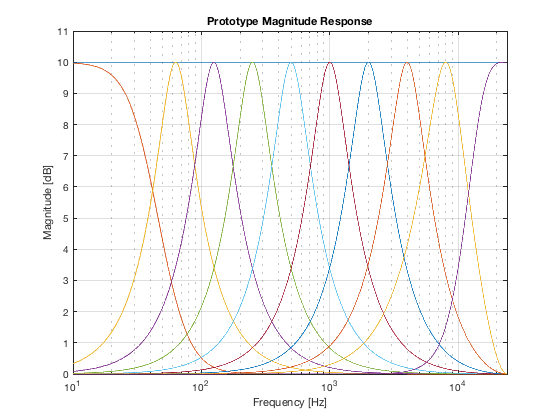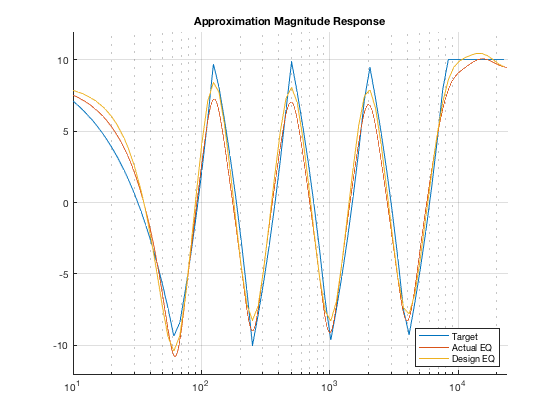Contents
- All About Audio Equalization: Solutions and Frontiers
- Initialization
- desgin prototype of the biquad sections
- compute optimal parametric EQ gains
Called Functions
All About Audio Equalization: Solutions and Frontiers
by V. Välimäki and J. Reiss, in Applied Sciences, vol. 6, no. 5, p. 129, May 2016.
Reproduce in Code (c) Sebastian Jiro Schlecht: Monday, 7. January 2019
close all; clear; clc;
Initialization
Setup variables such as sampling frequency, center frequencies and control frequencies, and command gains
fs = 48000; fftLen = 2^16; centerFrequencies = [ 63, 125, 250, 500, 1000, 2000, 4000, 8000]; % Hz ShelvingCrossover = [46 11360]; % Hz numFreq = length(centerFrequencies) + length(ShelvingCrossover); shelvingOmega = hertz2rad(ShelvingCrossover, fs); centerOmega = hertz2rad(centerFrequencies, fs); R = 2.7; % control frequencies are spaced logarithmically numControl = 100; controlFrequencies = round(logspace(log10(1), log10(fs/2.1),numControl+1)); % target magnitude response via command gains targetF = [1, centerFrequencies fs]; targetG = [1; -1; 1; -1; 1; -1; 1; -1; 1; 1]*10; % dB targetInterp = interp1(targetF, targetG, controlFrequencies)';
desgin prototype of the biquad sections
prototypeGain = 10; % dB prototypeGainArray = prototypeGain * ones(numFreq+1,1); prototypeSOS = proportionalParametricEQ(centerOmega, shelvingOmega, R, prototypeGainArray); [G,prototypeH,prototypeW] = probeSOS (prototypeSOS, controlFrequencies, fftLen, fs); G = G / prototypeGain; % dB vs control frequencies % plot figure(1); semilogx(prototypeW,mag2db(abs(prototypeH))) ylim([0 11]) xlim([10 fs/2]) grid on; title('Prototype Magnitude Response') xlabel('Frequency [Hz]') ylabel('Magnitude [dB]')

compute optimal parametric EQ gains
Either you can use a unconstrained linear solver or introduce gain bounds at [-20dB,+20dB] with acceptable deviation from the self-similarity property. The plot shows the deviation between design curve and actual curve.
upperBound = [Inf, 2 * prototypeGain * ones(1,numFreq)]; lowerBound = -upperBound; optG = lsqlin(G, targetInterp, [],[],[],[], lowerBound, upperBound); % optG = G\targetInterp; % unconstrained solution optimalSOS = proportionalParametricEQ( centerOmega, shelvingOmega, R, optG ); % plot figure(2); hold on; grid on; [hOpt,wOpt] = freqz(optimalSOS,fftLen,fs); plot(controlFrequencies, targetInterp); plot(wOpt,mag2db(abs(hOpt))) plot(controlFrequencies, G*optG) set(gca, 'xScale', 'log') ylim([-12 12]) xlim([10 fs/2]) title('Approximation Magnitude Response') legend('Target', 'Actual EQ', 'Design EQ','Location','SouthEast');
Minimum found that satisfies the constraints. Optimization completed because the objective function is non-decreasing in feasible directions, to within the default value of the optimality tolerance, and constraints are satisfied to within the default value of the constraint tolerance.
